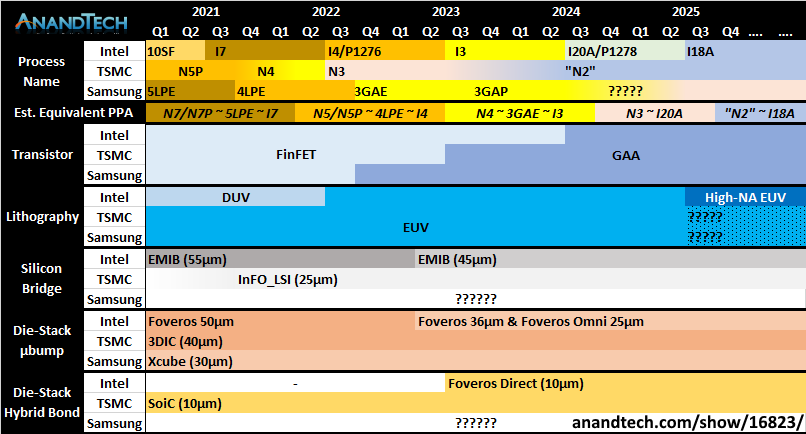Intel's Process Roadmap to 2025: with 4nm, 3nm, 20A and 18A?!
by Dr. Ian Cutress on July 26, 2021 5:00 PM ESTCustomers Customers Customers
As a roadmap announcement today, the focus isn’t so much on the customers but on the technology. Because Intel is moving into a phase where it expects its IFS offerings to compete against the established players, it has to consider its disclosures with respect to both its internal use and any external interest, which is a new concept for the company – at least on this scale compared to its previous foundry efforts.
Intel CEO Pat Gelsinger, in the company’s Q3 financial call last week, was keen to point out that they already have a large hyperscaler customer signed up for their next generation packaging technology, however today there would appear to also be another customer in the mix. Now we assume that Intel’s Foundry Services is talking to 100s of chip companies, big and small, but it doesn’t take much to sign an NDA to start to talk – what will be interesting is when customers start making commitments to using Intel’s facilities, and if any of those are volume orders.
As part of the announcement today, Intel held a little bit back from us, saying that they are saving some of the details specifically for the event that is going on as we publish this piece. All we know is that our draft press release has a big yellow bar that says ‘[customer news]’ on it, right next to Intel’s 20A process node details.
For reference, Intel 20A is a 2024 technology using first generation Gate-All-Around transistors, marketed as RibbonFETs, as well as backside power delivery, marketed as PowerVias. At this time Intel expects to have second/third-generation EMIB available as well as fourth-generation Foveros Direct. So if a customer is already committing to Intel 20A, there’s going to be a lot of potential here.
When the announcement is made, we will update this news article.
To conclude, Intel maintains that these roadmaps will showcase a clear path to process performance leadership* by 2025. It’s a tall order, and the company has to execute better than it has in recent memory - but that’s kind of why the company has rehired a number of former Intel experts and fellows in research, product design, and execution.
*as measured by performance per watt at iso-power
Here's a secondary comparison chart (compared to the one on page one) with all three main foundry offerings listed in each of the main segments that Intel has discussed today.











326 Comments
View All Comments
Spunjji - Thursday, July 29, 2021 - link
Then someone might expect them to actually release a product approaching that density 😬arashi - Monday, July 26, 2021 - link
Especially when Intel has failed to ship anything remotely close to the peak density while TSMC is. Ian has lost credibility with his hype-boy-isms in this article.arashi - Monday, July 26, 2021 - link
Just compare the wording to the sponsored posts. I don't see a difference.mode_13h - Monday, July 26, 2021 - link
That's because the article is reporting on their press conference. So, all they're doing it taking the Intel-provided slides and commentary and making it more accessible for us plebs.Where I think you could legitimately say Ian has a bit of Stockholm Syndrome is in his lobbying for "industry standard naming". I think it's crossing the line, as journalist, to do anything more than ask his interviewees questions about this confusion.
Oxford Guy - Wednesday, July 28, 2021 - link
You really believe that — that journalists are stenographers?Finding one who is actually independent (since media is owned by the wealthy) is like trying to find citizens of Atlantis. (Also, even with a valiant attempt at true objectivity we’re all products of culture as well as genetic biases — aka personality.)
However, there is a some range in journalism between the stenographer for corporate/plutocratic marketing and someone who has an advanced/terminal degree in the field being covered. The latter can, at least, make the effort to have a dialogue rather than passively listening to monologue and regurgitating it on cue.
mode_13h - Thursday, July 29, 2021 - link
> You really believe that — that journalists are stenographers?No, of course not. They can & should add context and critical analysis. I think the article does some of that, but it's primarily concerned with conveying and explaining Intel's message.
I was simply trying to explain why it reads like a press release. It's hard to faithfully cover a press event and *not* have it sound somewhat like that.
Oxford Guy - Wednesday, August 11, 2021 - link
‘No, of course not. They can & should add context and critical analysis’Don’t contradict what you said before in this very topic or anything.
‘I was simply trying to explain why it reads like a press release.’
You could have said that rather than what you did say.
mode_13h - Thursday, August 12, 2021 - link
> Don’t contradict what you said beforeIt's not. It's a clarification. My position on this issue hasn't changed, so any apparent contradiction is probably a case of misinterpretation or where I was being too terse. I generally try to keep my comments short and to-the-point, sometimes to a fault.
ikjadoon - Monday, July 26, 2021 - link
OK, wild, what?TSMC & Samsung have been doing this for *years*: blatantly misleading people. There is no "TSMC 12nm" nor a "TSMC 6nm" nor a "TSMC 4nm". These are not actually genuinely noticeable peak density increases versus 16nm, 7nm, nor 5nm.
nandnandnand - Tuesday, July 27, 2021 - link
>These are not actually genuinely noticeable peak density increases versus 16nm, 7nm, nor 5nm.Well that's not true. TSMC 6nm is 18% more dense than TSMC 7nm, which is more than what a 6/7=0.857... calculation would imply.